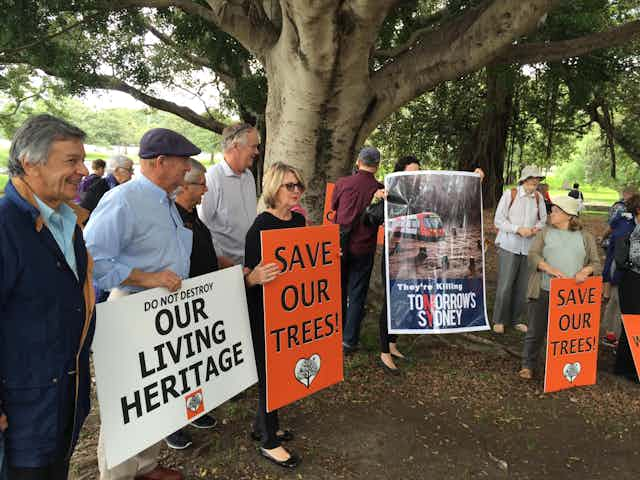Looking out of the window on my morning bus journey from Kensington into Sydney’s CBD, I saw more trees being cut down to make way for the new light rail. This time, it was the historical fig trees that line Anzac Parade.
Trees like these provide a host of important ecological, environmental and aesthetic benefits. I – like many Sydneysiders – am deeply saddened by their loss. It leaves me wondering, why can’t we have a modern transport system but also enjoy a nice view along the way?
In meeting the needs of growing populations across our capital cities, it is vital that we have efficient, integrated public transport, with enough capacity to meet demand. The challenge of retrofitting transport systems into an established urban fabric means difficult decisions are inevitable. But what if building these new transport systems actually leaves parts of our cities more vulnerable to even bigger challenges, such as climate change?
Sydney and Canberra are forging ahead with light rail projects intended to reduce traffic congestion and improve accessibility. However, in both cities a significant number of mature trees will be impacted.
In Canberra, the ACT government is set to remove approximately 860 trees. In Sydney, about 1277 mature trees will either be removed or have their canopy or roots pruned.
Of the condemned trees, 871 are classified as trees of significant value. These trees, some of which were 160 years old, provide an array of benefits that make our cities liveable. These include clean air, amenity, biodiversity and cooling in hot temperatures.
The tree felling has has caused outrage among Sydney residents who are frustrated by the way planning decisions were made. A controversial amendment to the route to accommodate private commercial interests meant many trees were removed at the end of 2015.
Cutting down cities’ natural cooling system
Many places in Australia are going to become hotter with climate change. The number of extreme heat days over 35 degrees is projected to increase.
The impact will be greater in cities due to the “heat island effect”. This amplifies the impacts of heat due to the abundance of hard and dark surfaces.

The table above shows that, by 2070, heatwaves are projected to nearly double the long-term average in both Sydney and Canberra. This is significant as major heatwaves are Australia’s deadliest natural hazard. Extreme heat accounts for 55% more deaths than all other natural hazards combined.
A recent study showed that heat stress on the workforce costs the Australian economy US$6.2 billion a year due to absenteeism, reduced productivity and injuries. This is a problem that has become too big to ignore.

However, increasing the amount of green cover in urban areas can help us adapt to extreme heat. Urban street trees provide the only cost-effective way to cool our cities, due to the direct correlation between heat and tree canopy cover.
Trees create their own microclimates through a combination of shading and the evapotranspiration of water from leaves, which reduces ambient temperatures. Removing canopy trees today means those cooling benefits will be gone for at least another 20 years – and that is only if new plantings survive to maturity.
The federal government recently announced plans for decade-by-decade goals – out to 2060 – for increasing overall tree coverage in our cities. Internationally, cities such as Madrid, which regularly experiences temperatures over 30 degrees and extremes above 40 degrees in summer, are starting to see the serious health implications of heat islands. These cities are implementing bold strategies to increase urban tree cover.
It is clear that to adapt to a hotter climate, we need to retain as many trees as possible. Australia needs to set strong targets to increase urban tree cover.
It could have been a very different outcome in Sydney if the value of the trees had been considered equally in the planning decisions. We could have had a modern transport system and valuable and attractive tree-lined view to enhance the journey.
As someone who works in the area of climate change adaptation, I can see how the loss of these trees will have major environmental, economic and social consequences. As a local resident who has walked and cycled daily under the trees, the loss has a personal cost.
It is imperative that we find better ways to balance the needs of growing city populations, while ensuring the protection of the natural environment we ultimately rely on to survive.

